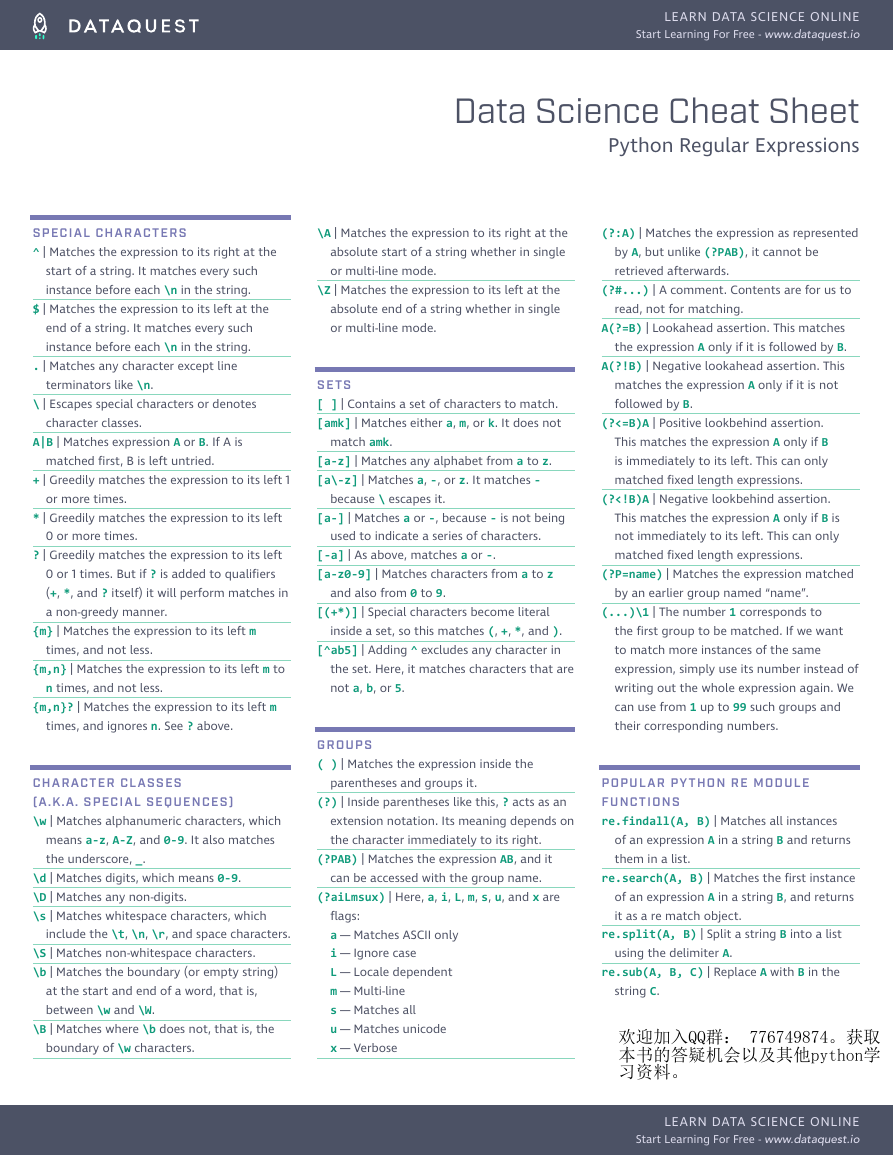LEARN DATA SCIENCE ONLINE
Start Learning For Free - www.dataquest.io
Data Science Cheat Sheet
Python Regular Expressions
SPECIAL CHARACTERS
^ | Matches the expression to its right at the
start of a string. It matches every such
instance before each \n in the string.
$ | Matches the expression to its left at the
end of a string. It matches every such
instance before each \n in the string.
. | Matches any character except line
terminators like \n.
\ | Escapes special characters or denotes
character classes.
A|B | Matches expression A or B. If A is
matched first, B is left untried.
+ | Greedily matches the expression to its left 1
or more times.
\A | Matches the expression to its right at the
absolute start of a string whether in single
or multi-line mode.
\Z | Matches the expression to its left at the
absolute end of a string whether in single
or multi-line mode.
SETS
[ ] | Contains a set of characters to match.
[amk] | Matches either a, m, or k. It does not
match amk.
[a-z] | Matches any alphabet from a to z.
[a\-z] | Matches a, -, or z. It matches -
because \ escapes it.
* | Greedily matches the expression to its left
[a-] | Matches a or -, because - is not being
0 or more times.
? | Greedily matches the expression to its left
0 or 1 times. But if ? is added to qualifiers
(+, *, and ? itself) it will perform matches in
a non-greedy manner.
{m} | Matches the expression to its left m
times, and not less.
{m,n} | Matches the expression to its left m to
n times, and not less.
{m,n}? | Matches the expression to its left m
times, and ignores n. See ? above.
CHARACTER CLASSES
(A.K.A. SPECIAL SEQUENCES)
\w | Matches alphanumeric characters, which
means a-z, A-Z, and 0-9. It also matches
the underscore, _.
\d | Matches digits, which means 0-9.
\D | Matches any non-digits.
\s | Matches whitespace characters, which
include the \t, \n, \r, and space characters.
\S | Matches non-whitespace characters.
\b | Matches the boundary (or empty string)
at the start and end of a word, that is,
between \w and \W.
\B | Matches where \b does not, that is, the
boundary of \w characters.
used to indicate a series of characters.
[-a] | As above, matches a or -.
[a-z0-9] | Matches characters from a to z
and also from 0 to 9.
[(+*)] | Special characters become literal
inside a set, so this matches (, +, *, and ).
[^ab5] | Adding ^ excludes any character in
the set. Here, it matches characters that are
not a, b, or 5.
GROUPS
( ) | Matches the expression inside the
parentheses and groups it.
(?) | Inside parentheses like this, ? acts as an
extension notation. Its meaning depends on
the character immediately to its right.
(?PAB) | Matches the expression AB, and it
can be accessed with the group name.
(?aiLmsux) | Here, a, i, L, m, s, u, and x are
flags:
a — Matches ASCII only
i — Ignore case
L — Locale dependent
m — Multi-line
s — Matches all
u — Matches unicode
x — Verbose
(?:A) | Matches the expression as represented
by A, but unlike (?PAB), it cannot be
retrieved afterwards.
(?#...) | A comment. Contents are for us to
read, not for matching.
A(?=B) | Lookahead assertion. This matches
the expression A only if it is followed by B.
A(?!B) | Negative lookahead assertion. This
matches the expression A only if it is not
followed by B.
(?<=B)A | Positive lookbehind assertion.
This matches the expression A only if B
is immediately to its left. This can only
matched fixed length expressions.
(?


 2023年江西萍乡中考道德与法治真题及答案.doc
2023年江西萍乡中考道德与法治真题及答案.doc 2012年重庆南川中考生物真题及答案.doc
2012年重庆南川中考生物真题及答案.doc 2013年江西师范大学地理学综合及文艺理论基础考研真题.doc
2013年江西师范大学地理学综合及文艺理论基础考研真题.doc 2020年四川甘孜小升初语文真题及答案I卷.doc
2020年四川甘孜小升初语文真题及答案I卷.doc 2020年注册岩土工程师专业基础考试真题及答案.doc
2020年注册岩土工程师专业基础考试真题及答案.doc 2023-2024学年福建省厦门市九年级上学期数学月考试题及答案.doc
2023-2024学年福建省厦门市九年级上学期数学月考试题及答案.doc 2021-2022学年辽宁省沈阳市大东区九年级上学期语文期末试题及答案.doc
2021-2022学年辽宁省沈阳市大东区九年级上学期语文期末试题及答案.doc 2022-2023学年北京东城区初三第一学期物理期末试卷及答案.doc
2022-2023学年北京东城区初三第一学期物理期末试卷及答案.doc 2018上半年江西教师资格初中地理学科知识与教学能力真题及答案.doc
2018上半年江西教师资格初中地理学科知识与教学能力真题及答案.doc 2012年河北国家公务员申论考试真题及答案-省级.doc
2012年河北国家公务员申论考试真题及答案-省级.doc 2020-2021学年江苏省扬州市江都区邵樊片九年级上学期数学第一次质量检测试题及答案.doc
2020-2021学年江苏省扬州市江都区邵樊片九年级上学期数学第一次质量检测试题及答案.doc 2022下半年黑龙江教师资格证中学综合素质真题及答案.doc
2022下半年黑龙江教师资格证中学综合素质真题及答案.doc